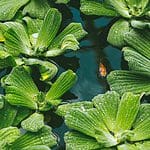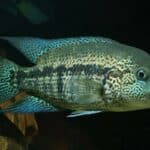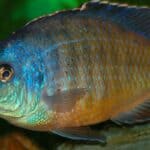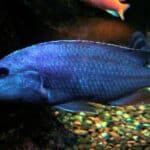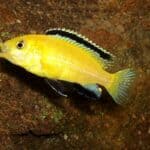The Convict Cichlid, (Amatitlania nigrofasciata) is an absolutely beautiful little freshwater fish that has been a favorite among aquarists for many years due to its striking zebra stripe pattern.
The species hails from the streams and lakes of Central America, and can be found along the eastern coast from Guatemala to Costa Rica, and along the western coast from Honduras to Panama.
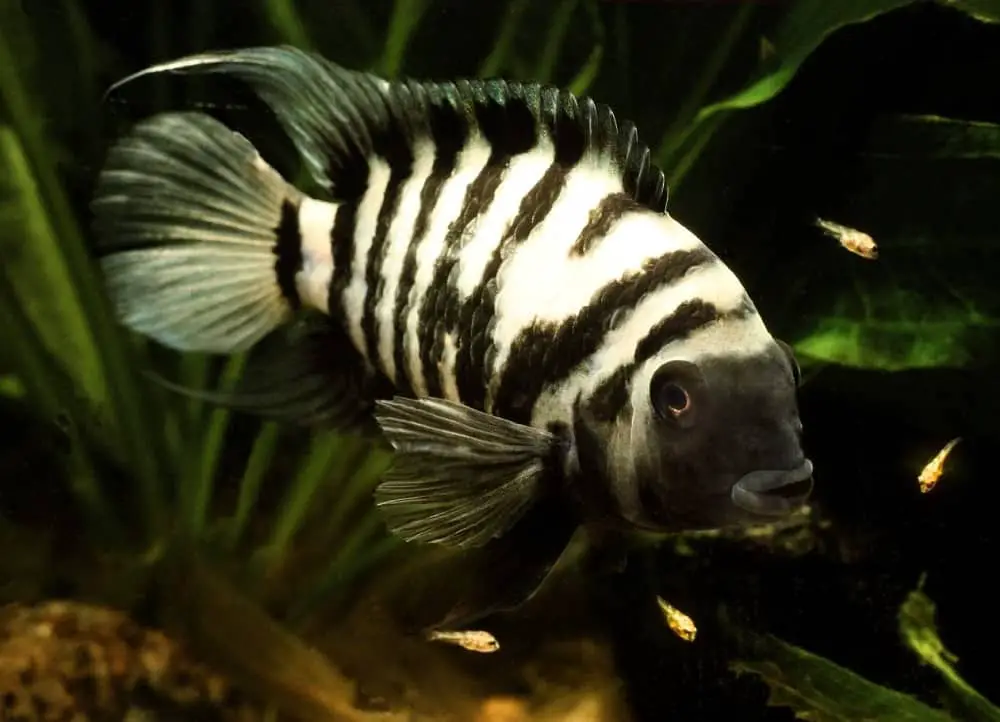
Interestingly, the Convict Cichlid can now also be found in Australia, well outside its natural range. This is due to the water conditions in Victoria and Queensland, which are suitable to the Convict Cichlid’s needs. They have also been introduced as wild swimmers in Japan, Mexico and Taiwan.
Although they aren’t an ‘expert-only’ aquarium buy, Convict Cichlids do require some specialist care due to their somewhat aggressive nature. However, if correctly looked after, these guys make a marvellous addition to any aquarist’s collection.
Care Guide
Tank Size
The minimum tank size for the Convict Cichlid is ideally 30 gallons. Although this may seem large for a relatively small fish, it is crucial to give them plenty of swimming room to avoid these fish becoming stressed and unhappy.
30 gallon tanks do not cost that much more than 20 gallon alternatives, yet the added capacity will improve your Convict Cichlid’s general health and even their life expectancy.
Tank Mates
The Convict Cichlid is a feisty fish and so you have to think carefully before putting one in a community tank. They tend to become aggressive with other cichlid relatives, however they can be successfully mixed with Oscar fish, Jack Dempsey fish, Silver dollar fish, Pictus Catfish and Clown Loaches.
You should not put a male and female Convict Cichlid in a community tank as they will become very territorial and you will really ramp up the probability of violent behavior.
Same Species Tanks
Most people tend to put Convict Cichlids in solo tanks or put a male and female in a tank as a pair. The more Convict Cichlids you add to a same species tank, the higher the chance that they will become aggressive.
Water Parameters
The Convict Cichlid is a resilient fish and will be able to tolerate a range of water conditions, however, achieving the ideal parameters for this species will enhance your fish’s lifespan and health.
The Convict Cichlid likes a water temperature of between 79 – 84 degrees Fahrenheit, and water PH levels of between 6.5 and 8. The water hardness in their tank should be between 10 – 15 dH for optimum conditions. In order to maintain these levels, it is advisable you purchase a reliable water testing kit and perform checks at least once a week.
What To Put In Their Tank
When deciding what to put in your Convict Cichlid’s tank, it is important to consider what the conditions in their natural habitat are, then try to mimic them as closely as possible.
In the waters of South America, the Convict Cichlid enjoys rooting about in lots of vegetation, so it is good to include plants in your tank. Hornwort is a great option, as well as floating plants whose roots will hang down and provide lots of tendrils for the fish to explore in.
The substrate should be soft since Convict Cichlids tend to root around on the bottom of the tank intermittently. If the substrate is too rough the fish may sustain cuts to their bellies, therefore sand is a great choice.
You may also want to consider how hardy your plants are, as the Convict Cichlid can dig about quite aggressively at times and not all plants withstand their advances.
Rocks and driftwood are another great addition to any Convict cichlid’s tank as they provide places for the fish to hunker down and hide. This really helps if they are feeling aggressive because without these covered spots they can become quite stressed and will act out.
In the wild, these fish enjoy a gentle current rather than still water, therefore a very mellow current in their tank will make them feel more at home.
Common Diseases
Although Convict Cichlids aren’t plagued by any specific diseases and tend to be fairly hardy little guys, they are still susceptible to all the usual freshwater infections. Two such diseases that you should keep a look out for are Ich and fin rot.
These occur if fish are kept in subpar conditions and aren’t given the right diet. Therefore, keep your Convict Cichlid well-fed and their water parameters stable, and you will be far less likely to be impacted by disease.
A great idea is to inspect your fish for signs of illness regularly. You might observe changes in their behavior, such as lack of appetite or sluggishness, or visible symptoms, such as white spots appearing on their body. If you do notice any such changes, you should take action immediately in order to give your fish the best chance of recovery.
Food and Diet
The Convict Cichlid will eat just about anything – which sounds great, but is actually more troublesome than many beginners realise. Because of their voracious appetite, they will eat foods that are bad for them if you put them in the tank, and they will also overeat if they are fed too often.
As a result, Convict Cichlid owners should only offer these fish suitable foods and try to maintain a regular feeding timetable. Once every morning and evening is a good option.
In the wild, Convict Cichlids are omnivores, meaning they eat both meat protein and plant matter. Therefore, a mixture of pellets, flakes and frozen foods, with the occasional live food offering, will work well. Brine shrimp and bloodworms are real Convict Cichlid favorites.
Lifespan
The Convict Cichlid has an average lifespan of between 8-10 years, and many can live longer than this if properly looked after.
A balanced diet, correct water conditions and care will ensure that you get the most out of your fish, yet genetics are also a factor in the Convict Cichlid’s life expectancy. Subpar breeding will negatively impact their longevity, so be sure to do your research and only buy from a certified breeder.
Appearance
The Convict Cichlid gets its name from the distinctive black bars that run vertically down its body. These are the Convict Cichlid’s main selling point and what make them so desirable amongst aquarists. The bars are generally evenly spaced and sized and there are usually about 8 of them.
The number of bars can vary depending on age, sex and genetics, but good breeders will hope you produce fish with plenty of well-defined stripes.
The bars are black in color, while the rest of the Convict Cichlid’s body is a subtle blend of blueish-grey. This body color can differ slightly amongst the fish but not wildly, so don’t be fooled into thinking you are buying a rare Convict Cichlid with a purple body tone – it will simply be the lighting in the tank.
These fish have a very typical body shape for any cichlid, with a long dorsal fin that extends from a quarter of the way back from their mouth, right down to the start of their caudal peduncle. The dorsal fin is translucent and looks really cool because the black bars continue up onto its surface.
The dorsal and anal fins both tilt back slightly, like sails blowing in the wind, making them very beautiful to watch in the water. The caudal fin is completely translucent and free of stripes. It is shaped a little like a seashell and provides lots of power and mobility for the Convict Cichlid as it swims.
Size
Convict Cichlids grow to an average length of 4-5 inches, which is small compared to many of their cichlid relatives.
Behaviour and Temperament
As the ‘convict’ part of their name suggests, these fish can be feisty and rather troublesome at times, which makes them a sensible choice for more experienced aquarists.
They tend to swim in the middle section of the water column but are pretty active and will regularly duck down to the substrate to dig about and explore.
They enjoy hiding behind rocks and plants and if they aren’t able to do so they can become unnecessarily stressed and aggressive. Be sure to provide lots of shady spots where they can take a time-out if they need it.
As they are fairly territorial, these fish need a large tank with plenty of swimming room, and they love to explore so you will have fun watching them use every area of the tank.
Breeding
You won’t have any trouble getting your Convict Cichlids to breed. They are just about the most successful freshwater fish at breeding in home tanks that you can get.
All you need to do is provide plenty of space (40-50 gallons for the pair ideally), and lots of rocks and plants for the female to lay her eggs.
You mustn’t let a breeding pair stay in a community tank because these fish are very feisty parents and will lash out at any fish that swims too near their eggs. Once the fry begin to develop you should remove the parents, because they soon become aggressive towards the babies.
Gender Differences: Male vs Female
Distinguishing between male and female Convict Cichlids can be pretty difficult. The most distinct difference between the sexes is the orange coloration on the bottom of the female’s body. The females also tend to have a slightly rounder belly shape than the males.
Fun Fact
- The Convict Cichlid is one of the only fish where the female is more colorful than the male!

